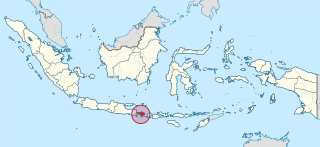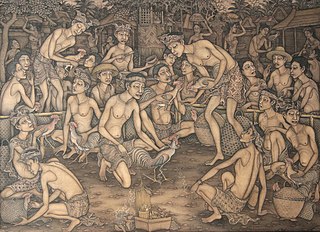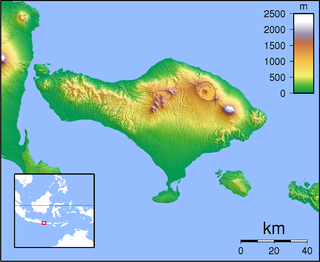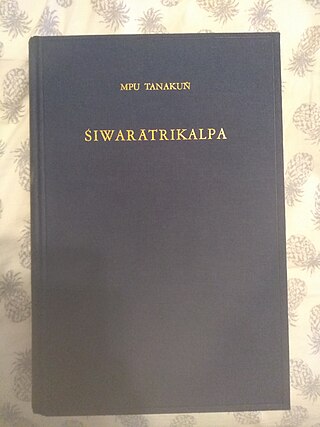Related Research Articles

Bali is a province of Indonesia and the westernmost of the Lesser Sunda Islands. East of Java and west of Lombok, the province includes the island of Bali and a few smaller offshore islands, notably Nusa Penida, Nusa Lembongan, and Nusa Ceningan to the southeast. The provincial capital, Denpasar, is the most populous city in the Lesser Sunda Islands and the second-largest, after Makassar, in Eastern Indonesia. The upland town of Ubud in Greater Denpasar is considered Bali's cultural centre. The province is Indonesia's main tourist destination, with a significant rise in tourism since the 1980s, and becoming an Indonesian area of overtourism. Tourism-related business makes up 80% of the Bali economy.

Michael Tenzer is a composer, performer, and music educator and scholar.
The island of Bali has a system of social organization similar to the Indian caste system.

Balinese Hinduism is the form of Hinduism practised by the majority of the population of Bali. This is particularly associated with the Balinese people residing on the island, and represents a distinct form of Hindu worship incorporating local animism, ancestor worship or Pitru Paksha, and reverence for Buddhist saints or Bodhisattava.

The Balinese people are an Austronesian ethnic group native to the Indonesian island of Bali. The Balinese population of 4.2 million live mostly on the island of Bali, making up 89% of the island's population. There are also significant populations on the island of Lombok and in the easternmost regions of Java.

Hinduism is the third-largest religion in Indonesia, based on civil registration data in 2022 from Ministry of Home Affairs, is practised by about 1.69% of the total population, and almost 87% of the population in Bali. Hinduism was the dominant religion in the country before the arrival of Islam and is one of the six official religions of Indonesia today. Hinduism came to Indonesia in the 1st-century through Indian traders, sailors, scholars and priests. A syncretic fusion of pre-existing Javanese folk religion, culture and Hindu ideas, that from the 6th-century also synthesized Buddhist ideas as well, evolved as the Indonesian version of Hinduism. These ideas continued to develop during the Srivijaya and Majapahit empires. About 1400 CE, these kingdoms were introduced to Islam from coast-based Muslim traders, and thereafter Hinduism, which was previously the dominant religion in the region, mostly vanished from many of the islands of Indonesia.

Balinese art is an art of Hindu-Javanese origin that grew from the work of artisans of the Majapahit Kingdom, with their expansion to Bali in the late 14th century. From the sixteenth until the twentieth centuries, the village of Kamasan, Klungkung, was the centre of classical Balinese art. During the first part of the twentieth century, new varieties of Balinese art developed. Since the late twentieth century, Ubud and its neighboring villages established a reputation as the center of Balinese art.
Indonesian Australians are Australian citizens and residents of Indonesian origin. 48,836 Australian residents declared Indonesian ancestry on the 2011 Australian Census, while 63,160 stated they were born in Indonesia.

The Klungkung Palace, officially Puri Agung Semarapura, is a historical building complex situated in Semarapura, the capital of the Klungkung Regency (kabupaten) on Bali, Indonesia.
Gelgel is a village (desa) in the regency (kabupaten) of Klungkung, on Bali, Indonesia. The village, near the coast four kilometers south of the regency capital Semarapura, contains some structures of cultural interest and is known for its pottery and handwoven ceremonial songket cloth.

The History of Bali covers a period from the Paleolithic to the present, and is characterized by migrations of people and cultures from other parts of Asia. In the 16th century, the history of Bali started to be marked by Western influence with the arrival of Europeans, to become, after a long and difficult colonial period under the Dutch, an example of the preservation of traditional cultures and a key tourist destination.
Udayana Warmadewa, also Udayana the Great or Dharmmodayana Warmadewa, was a king of the island of Bali in the 10th century. He belongs to the Warmadewa dynasty. He was married to the Javanese queen Mahendradatta, also known as Gunapriyadharmapatni. Their son was the famous Airlangga, who replaced the overthrown emperor of Java Dharmawangsa, and ruled in both Java and his original home of Bali. Mahendradatta and Udayana co-ruled Bali, issuing inscriptions in both their names.

Dalem Baturenggong, also called Waturenggong or Enggong, was a King (Dalem) of Bali who is believed to have reigned in the mid 16th century. He is in particular associated with the golden age of the Balinese kingdom of Gelgel, with political expansion and cultural and religious renovation. In Balinese historiography he represented an epic vision of kingship that served as a model for later rulers on the island.

Dalem Segening was a king of Bali who reigned in the first half of the 17th century, his exact dating being still uncertain. He belonged to a dynasty which originated from Majapahit on Java, and ruled from the palace (puri) of Gelgel.

Gambuh is an ancient form of Balinese dance-drama. It is accompanied by musicians in a gamelan gambuh ensemble.
Harry Aveling is an Australian scholar, translator and teacher. He specialises in Indonesian and Malaysian literature, and Translation Studies. He received the degrees of Doctor of Philosophy in Malay Studies from the National University of Singapore and Doctor of Creative Arts (DCA) from the University of Technology, Sydney. Besides his academic writing, he has translated extensively from Indonesian and Malay, from Vietnamese Francophone literature, and also co-translated from Hindi. He has been awarded the Anugerah Pengembangan Sastra for his translation work. Aveling has two sons, a daughter and five granddaughters.
Mangku Muriati is a traditional-style Balinese painter and priestess from Kamasan village near Klungkung, Bali, Indonesia.

Ayu Bulantrisna Djelantik was a Dutch-born Indonesian traditional Balinese dancer, ENT specialist, and a lecturer at the faculty of medicine at Padjadjaran University.

Śiwarātrikalpa, also known as the Kakawin Lubdhaka is an Old Javanese Hindu kakawin text written by Mpu Tanakung. This text aimed to spread the observance of Maha Shivaratri from the Vijayanagara Empire, who had given a great impetus to the revival of Saivite Hinduism, to the Hindus of Indonesia. It is believed to have been composed about 600 years ago, between 1466 and 1478, at a point when the Saivism sect of Hinduism dominated Java. Scholars have theorized that this revivalist zeal in Java was the result of the emerging Malacca Sultanate, through which Islam had been making gains in Java, and Indonesia in general.

Arja, also known as Balinese opera, is a popular form of Balinese theatre which combines elements of opera, dance, and drama. It was created in 1825 for the funeral of a Balinese prince. In the beginning, it had an all-male cast, but since the 20th century, all performers have been women.
References
- ↑ "Adrian Vickers". University of Sydney . Retrieved 16 August 2015.
- ↑ "Adrian Vickers Staff profile page". University of Sydney .
- ↑ "Adrian Vickers' Indonesia Blog". Archived from the original on 1 September 2015. Retrieved 16 August 2015.
- ↑ "2016 Queensland Literary Award winners". Queensland Literary Awards. Archived from the original on 8 October 2017. Retrieved 4 October 2017.
- ↑ "Adrian Vickers". Australian Academy of the Humanities . Retrieved 2 October 2020.